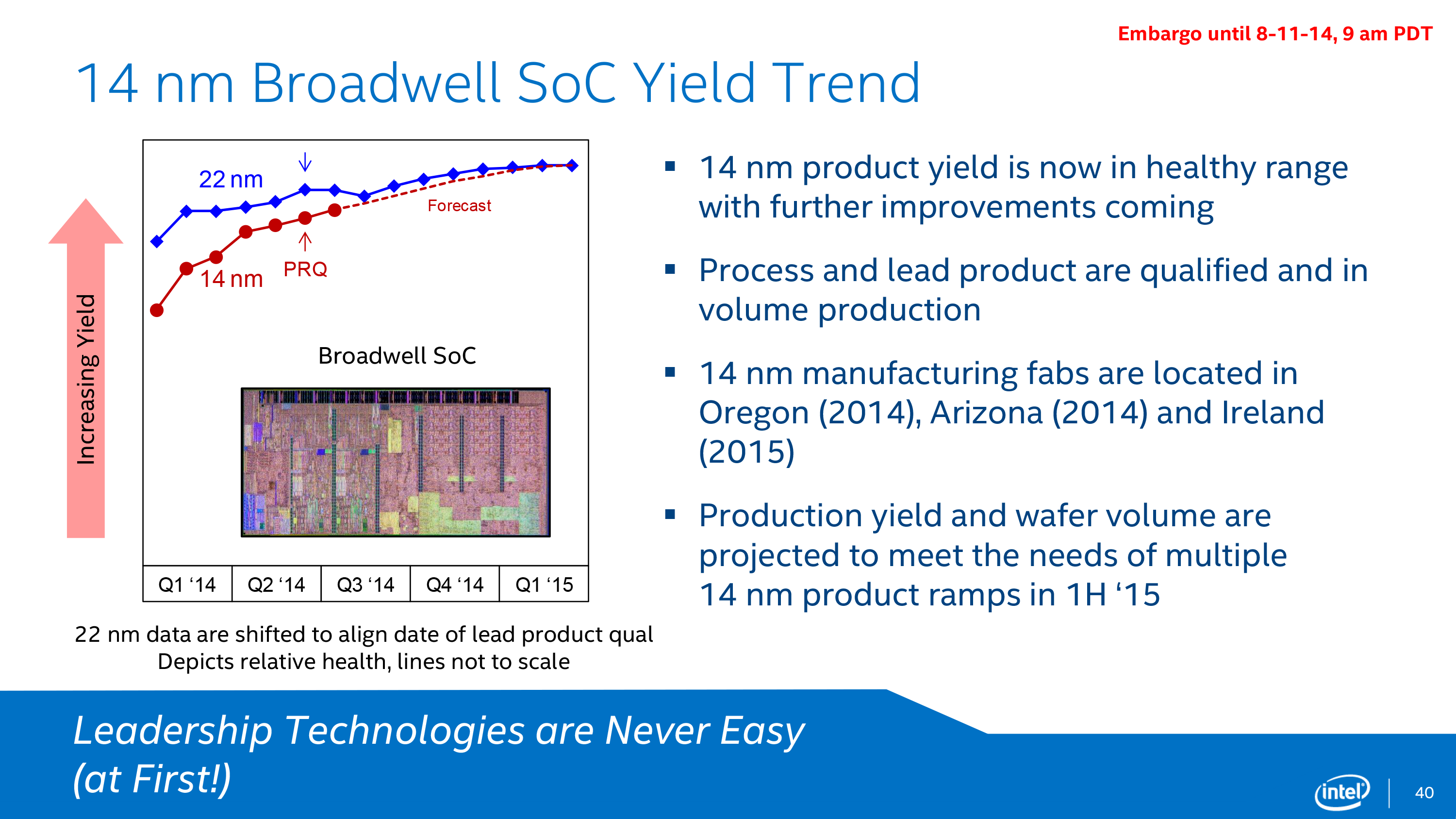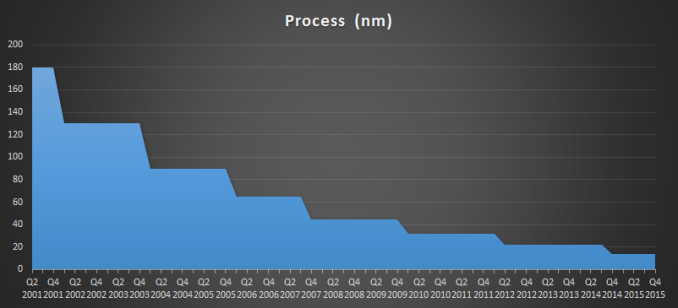Intel’s ‘Tick-Tock’ Seemingly Dead, Becomes ‘Process-Architecture-Optimization’
by Ian Cutress on March 22, 2016 6:45 PM EST
As reported at The Motley Fool, Intel’s latest 10-K / annual report filing would seem to suggest that the ‘Tick-Tock’ strategy of introducing a new lithographic process note in one product cycle (a ‘tick’) and then an upgraded microarchitecture the next product cycle (a ‘tock’) is going to fall by the wayside for the next two lithographic nodes at a minimum, to be replaced with a three element cycle known as ‘Process-Architecture-Optimization’.
Intel’s Tick-Tock strategy has been the bedrock of their microprocessor dominance of the last decade. Throughout the tenure, every other year Intel would upgrade their fabrication plants to be able to produce processors with a smaller feature set, improving die area, power consumption, and slight optimizations of the microarchitecture, and in the years between the upgrades would launch a new set of processors based on a wholly new (sometimes paradigm shifting) microarchitecture for large performance upgrades. However, due to the difficulty of implementing a ‘tick’, the ever decreasing process node size and complexity therein, as reported previously with 14nm and the introduction of Kaby Lake, Intel’s latest filing would suggest that 10nm will follow a similar pattern as 14nm by introducing a third stage to the cadence.
From Intel's report: As part of our R&D efforts, we plan to introduce a new Intel Core microarchitecture for desktops, notebooks (including Ultrabook devices and 2 in 1 systems), and Intel Xeon processors on a regular cadence. We expect to lengthen the amount of time we will utilize our 14nm and our next generation 10nm process technologies, further optimizing our products and process technologies while meeting the yearly market cadence for product introductions.
While the new PAO or ‘Process-Architecture-Optimization’ model is a direct result of the complexity of developing and implementing new lithographic nodes (Intel has even entered into a new five-year agreement with ASML to develop new extreme-ultra-violet lithographic techniques), but also with new process nodes typically comes a time where yields have to become high enough to remain financially viable in the long term. It has been well documented that the complexity of Intel’s 14nm node using the latest generation FinFET technology took longer than expected to reach maturation point compared to 22nm. As a result, product launches were stretched out and within a three-year cycle Intel was starting to produce only two new generations of products.
Intel’s current fabs in Ireland, Arizona, and Oregon are currently producing wafers on the 14nm node, with Israel joining Arizona and Oregon on the 22nm node. Intel also has agreements in place for third-party companies (such as Rockchip) to manufacture Intel’s parts for certain regional activity. As well as looking forward to 10nm, Intel’s filing also states projects in the work to move from 300mm wafers to 450mm wafers, reducing cost, although does not put a time frame on it.
The manufacturing lead Intel has had over the past few years over rivals such as Samsung, TSMC and Global Foundries, has put them in a commanding position in both home computing and enterprise. One could argue that by elongating the next two process nodes, Intel might lose ground on their advantage, especially as other companies start hitting their stride. However, the research gap is still there - Intel introduced 14nm back in August 2014, and has since released parts upwards of 400mm2, whereas Samsung 14nm / TSMC 16nm had to wait until the launch of the iPhone to see 100mm2 parts on the shelves, with Global Foundries still to launch their 14nm parts into products. While this relates to density, both power and performance are still considered to be on Intel’s side, especially for larger dies.
Intel's Current Process Over Time
On the product side of things, Intel’s strategy of keeping the same microarchitecture for two generations allows its business customers to guarantee the lifetime of the halo platform, and maintain consistency with CPU sockets in both consumer and enterprise. Moving to a three stage cycle has thrown some uncertainty on this, depending on how much ‘optimization’ will go into the PAO stage: whether it will be microarchitectural, better voltage and thermal qualities, or if it will be graphics focused, or even if it will keep the same socket/chipset. This has a knock on effect with Intel’s motherboard partners, who have used the updated socket and chipset strategy every two generations as a spike in revenue.
Suggested Reading:
EUV Lithography Makes Good Progress, Still Not Ready for Prime Time
Tick Tock on the Rocks: Intel Delays 10nm, adds 3rd Gen 14nm
The Intel Skylake Mobile and Desktop Launch with Microarchitecture Analysis
Source: Intel 10-K (via The Motley Fool)













98 Comments
View All Comments
DigitalFreak - Tuesday, March 22, 2016 - link
I'm surprised they stuck with "tick tock" this long.TEAMSWITCHER - Wednesday, March 23, 2016 - link
They haven't. Ivy-Bridge - Haswell - and Haswell Refresh was a PROCESS-ARCHITECTURE-OPTIMIZATION cycle.jasonelmore - Wednesday, March 23, 2016 - link
Great for consumers, we can use the same motherboard for 2-3 different CPU upgrades. Thats what i did with Haswell.. Still rocking z87 on a 4790Kmarc1000 - Thursday, March 24, 2016 - link
I am still on a 2500k @ 4ghz, and I see no need for more computing power for at least a couple more years.I have a P67 board with a couple USB 3 ports, below average power delivery (hence the 4ghz instead of 4.3 or 4.4, but that's ok), 16GB RAM and one SSD + HDD. and I run some virtualization/development, video conversion and games, so that's a bit above the average user needs. the price tag is just to high to justify 15% to 30% more performance. of course for some people the price is not that high, and the gap bigger. but not for everyone.
Samus - Monday, March 28, 2016 - link
Hah I have an old Intel P67 in my media center. It's the recalled stepping, too. Unfortunately because it's the early silicon it doesn't support any ivy bridge cpu's but I did finally upgrade from a Pentium G630 to an i5-2500k used off eBay to play with over locking because the G630 was clunky with transcoding when I'd VPN in to stream remotely.I have it at 4GHz on a mild closed loop cooler (Corsair H60) and did some benchmarks, and it's almost identical in performance to my Xeon E3-1230v3 Haswell workstation, and actually kills it in single threaded performance.
Another thing people don't know about the P67 is you can run ECC memory in it. I stumbled on this by surprise. No boot errors or anything. I don't know if the ECC is working (lol) but it's been stable that way for almost 5 years, (4) 1GB Kingston DIMMs I pulled from an HP server for an upgrade in 2011.
Intel actively killed ECC support from everything but the C2xx chipsets around the time the 60-series was introduced, so you would need a compatible CPU and Chipset. Many older Core-based non-Xeon cpu's surprisingly supported ECC from Nehalem through Sandybridge.
marc1000 - Wednesday, March 30, 2016 - link
nice to know i'm not alone. that ECC part is fun, but I would not change my 16gb of normal RAM to some ECC ram - I dont even have access to server-grade parts lol.put me in the line for i5-8600k, when it drops to palatable prices of course :)
extide - Thursday, March 24, 2016 - link
No, the haswell refresh was not a new series. They do a refresh like the haswell refresh almost every generation, although the refresh for the Haswell generation was much more widely talked about because of the Devil's Canyon chips. The architecture did not change at all. Kaby Lake will be the first true Optimization release.III-V - Tuesday, March 29, 2016 - link
Haswell Refresh was not an optimization, by any means. It was just a gap filler, and used the same silicon. Kaby Lake on the other hand will have some actual improvements baked in.rangerdavid - Tuesday, March 22, 2016 - link
Tick, Tock, Toe?solipsism - Tuesday, March 22, 2016 - link
Or Rikki-Tikki-Tavi¡